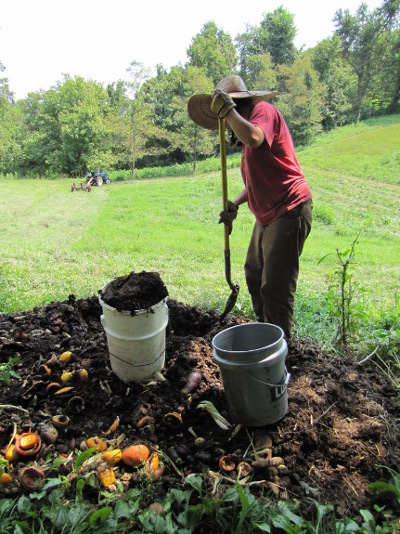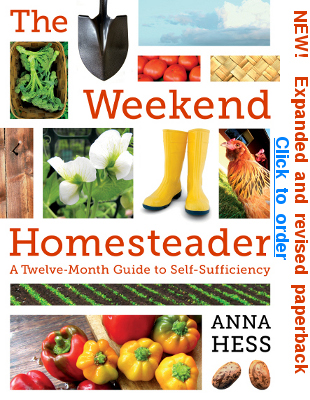
Rural biomass
 If your neighbors are farmers,
you may be in luck. Animal manure
(especially manure from dairy cows and well-loved horses) is some of
the highest quality biomass you can add to your garden. Here's a
run-down on the pros and cons of some of the main types of manures:
If your neighbors are farmers,
you may be in luck. Animal manure
(especially manure from dairy cows and well-loved horses) is some of
the highest quality biomass you can add to your garden. Here's a
run-down on the pros and cons of some of the main types of manures:
Cow manure is similar to horse manure but is wetter, so it might gross you out if not mixed with plenty of bedding. The highest quality cow manure comes from dairy cows.
Rabbit manure has a C:N around 12:1 and is dry, so you can get away with using fresh droppings straight on your garden. Rabbit manure tends to be seed-free and doesn't smell. You'll get more nitrogen if you include the urine-soaked bedding.
Chicken manure has a C:N of 8:1 and is high in phosphorus (which is often in short supply in the typical compost mix.) Too rich to be applied directly to your plants, chicken manure doesn't add much long term organic matter to the soil, so using the manure is a bit like pouring on chemical fertilizers. A monotonous diet of only chicken manure compost will tend to build up salts in your soil and result in an oversupply of phosphorus. Finally, chicken manure stinks if it's not enclosed in bedding. On the positive side, the high nitrogen content of chicken manure makes it a great addition to a slow-to-heat compost pile made of materials like autumn leaves or wood chips and chicken manure is usually seed-free. I consider chicken manure a good source of nitrogen and phosphorus in a well-rounded compost pile.
Don't let the mess-factor turn
you away from using free sources of manure. You can bring home
small quantities easily using a shovel and five gallon buckets.
Of course, you can haul much more in a pickup truck, loaded by hand
with a pitchfork or by a helpful neighbor with a scoop.
Spoiled hay is another type of
biomass that can sometimes be found for free in rural areas. Hay
is cut and dried pasture grasses, often full of seeds, which is meant
to be fed to livestock like cows and horses. (Even though hay
looks like straw, the two are very different materials and have
different uses on the farm.) If hay gets damp, it can mildew and
is no longer safe to feed to your animals, so farmers will often give
away the spoiled hay. From a gardening point of view, the quality
of hay varies widely depending on whether you've found spring hay (high
in nitrogen, low in seeds) or summer hay (high in carbon and seeds.)

Sawdust might be free for the
picking at carpentry shops or saw mills. Meanwhile, if you flag
down one of the crews that trim trees off the powerline or along the
sides of roads, they may dump a whole truckload of wood chips
in your yard. Both types of wood products have an extremely high
C:N, so you'll need to mix them with lots of high nitrogen materials
and compost for quite a while before using the result on your
garden. I let piles of plain wood chips rot for a couple of years
and then use the mulch around my fruit trees --- beneficial fungi love
well-rotted wood chips and the soil around my trees' roots gets
fluffier every year.
Rotten fruits and pomace can
sometimes be scavenged from orchards and cider mills. Pomace is
the
pulp, skins, and seeds left behind after you make apple cider.
Both of
these materials are wet and attract painfully-stinging yellowjackets,
so they're best mixed deep into a compost pile amid absorbent materials
like dry hay or sawdust. The fruit waste is high in nitrogen and
the
seeds will add phosphorus to your compost pile. Alternatively,
you
could feed both rotten fruits and pomace to your chickens, goats, or
other livestock.
Seaweed can often be picked
right off the beach if you live by the ocean. Seaweed is high in
nitrogen (19:1) and can be used as a quickly rotting mulch or can be
added to a compost pile. The major bonus of seaweed is the trace
minerals and potassium provided.
Learn
about other fun, cheap, and easy fall projects in Weekend
Homesteader: October.
| This post is part of our Scavening Biomass lunchtime series.
Read all of the entries: |
Want more in-depth information? Browse through our books.
Or explore more posts by date or by subject.
About us: Anna Hess and Mark Hamilton spent over a decade living self-sufficiently in the mountains of Virginia before moving north to start over from scratch in the foothills of Ohio. They've experimented with permaculture, no-till gardening, trailersteading, home-based microbusinesses and much more, writing about their adventures in both blogs and books.
Want to be notified when new comments are posted on this page? Click on the RSS button after you add a comment to subscribe to the comment feed, or simply check the box beside "email replies to me" while writing your comment.

In general, the answer to that question has to do with temperature as well as time. If you check out chapter 3 of the Humanure Handbook, you'll find a lot more information, but as a rule of thumb, if you're slow composting (keeping the temperature of the manure lower than around human body temperature), you should probably allow a year to be 100% safe. At the other extreme, if you get your compost pile up to 122 degrees Fahrenheit, you kill everything in 24 hours.
The other thing to consider with manure is that if you work it into the soil (or put it under a layer of mulch), any pathogenic bacteria are going to have a hard time reaching the part of the food you eat. Plus, a healthy soil will make short work of the pathogens. I don't worry at all about pathogens in the horse manure we use, and I've been known to use it nearly fresh when I was desperate.